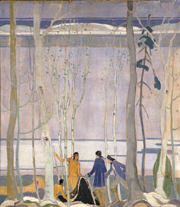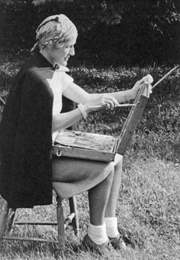 |
 |
|
|
 Indian Fur Traders (c.
1930)
Indian Fur Traders (c.
1930)
 Anne Savage at work.
Anne Savage at work.
|
by Susan Font
Anne Savage was just 27 when she became the art teacher at Baron Byng High
School on St. Urbain St., and right from the outset, she wanted to help
her students to value art in their daily life.
She did it by inspiring them to sketch and paint freely, and by bringing
art into the classroom. She was daring and different, especially in 1922,
and she became one of Canada’s most prominent female artists and a
legendary teacher.
Students became art educators
When Professor Emerita Leah Sherman looks at Savage’s paintings, recently
displayed in the Leonard and Bina Ellen Art Gallery, she’s looking
back in time.
Sherman was one of those dazzled students who went on to make art education
her career. Artist Alfred Pinsky, who, with Sherman, founded what became
the Faculty of Fine Arts and was its first dean, was another former student.
In Savage’s own work (right), movement is captured in the rounded shapes
that flow into each other in a rhythmic, dynamic composition. She was strongly
influenced by the Group of Seven, now icons of Canadian nationalism because
of their distinctive aesthetic, especially of landscape painting.
The young teacher brightened up the drab library of what was then a new
building by painting a series of large murals, each depicting an element
of Canadian history. Three of the murals went into storage when the school
closed in 1980. (The former Baron Byng now houses the offices of Sun Youth.)
Sherman appealed to the PSBGM Cultural Heritage Foundation and asked that
they be donated to Concordia. It took 20 years of negotiation, but the murals,
including one particularly beautiful native scene in rich umber and sienna,
are now part of the Ellen Gallery’s permanent collection. |
|
|



